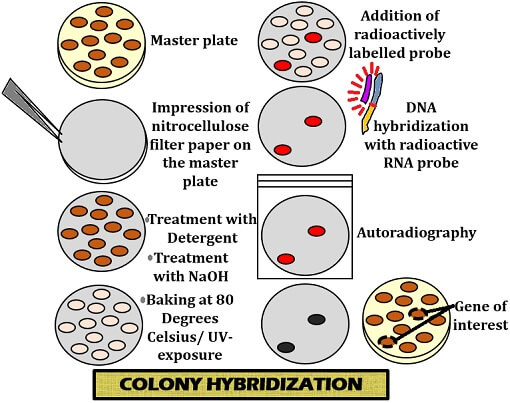Colony hybridization is the method first given by the scientists Grinstein and Hogness in the year 1975. This method isolates the specific DNA sequences or genes from the hybrid DNA. Colony hybridization makes the use of the nitrocellulose filter paper. This technique is very much similar to the replica plating.
Colony hybridization involves replicas preparation on the nitrocellulose membrane filter paper. It involves the in-situ transfer of bacterial cells from the master plate to the nitrocellulose membrane. The nitrocellulose filter paper passes through some washing methods, UV exposure, and the desired gene’s hybridisation with a specific probe.
The DNA hybridization occurs by using radioactive RNA followed by autoradiography. The hybridized DNA is then picked from the reference or master plate for further study. You will get to know the definition, process and the transferring medium used in the colony hybridization.
Content: Colony Hybridization
Definition of Colony Hybridization
Colony hybridization is the blot analysis technique where the bacterial cells are transferred from the solid nutrient medium to the absorbent material. It can define the method for isolating the specific DNA sequences or genes from the bacterial cells containing hybrid DNA using a nitrocellulose membrane filter. The transferring medium (nitrocellulose filter paper) is then subjected to several chemical and physical treatments.
Transferring Medium
The nitrocellulose filter paper is the transferring medium of the colony hybridization that forms the master plate’s replicas. The nitrocellulose acts as a membrane, containing the exact copies of the gene to that of the master plate. Nitrocellulose filter paper acts as the blotting-pad.
Ideal Properties of the Nitrocellulose filter paper
- The nitrocellulose filter paper comprises 100% pure nitrocellulose, where the cellulose undergoes nitration by the chemical reagent nitric acid.
- This membrane filter provides a high-quality transfer.
- Nitrocellulose filter paper possesses a 0.45 µm pore size that facilitates efficient transferring.
For colony hybridization, nitrocellulose filter paper goes through several steps like:
- Three times washing of the filter paper with distilled water.
- Placing of filter paper between the absorbent sheets.
- Autoclaving of filter medium at 120 degrees Celsius for 10 minutes.
- Drying of nitrocellulose filter paper in the hot air oven for up to 10 minutes.
- After all these steps, transfer the bacterial cells onto the filter membrane.
Process of Colony Hybridization
The process of colony hybridization involves the following steps:

Preparation of Master plate: First, inoculate the bacterial cell suspension on the solid agar medium to prepare the master plate. After inoculation, the number of bacterial colonies will develop with different plasmids on the master or reference plate.
Formation of replicas over a nitrocellulose filter: Then, transfer the bacterial cells from the master plate to the membrane or filter using a nitrocellulose filter. Press the nitrocellulose filter paper over the surface of the master plate. This compression of the filter membrane will form replicas or copies of the bacterial cells similar to the master plate.
Treatment of filter medium with SDS: After that, treat the nitrocellulose filter paper with the SDS (Sodium dodecyl sulfate) detergent to lyse the bacterial cells.
Treatment of filter medium with alkali: Treat the filter medium with the alkali (like sodium hydroxide) to separate the DNA into single strands.
Fixing DNA onto the filter medium: To fix the DNA onto the nitrocellulose filter paper, either bake the filter paper at 80 degrees Celsius or expose it to the UV light.
Addition of radioactive probe: Hybridize the nitrocellulose filter paper containing imprints of the plasmid DNA by adding the radioactive RNA probe. This radioactive RNA probe will code the desired gene of sequence from the bacterial cells.
Washing and autoradiography: Wash the filter paper to remove unbound probe particles. After that, expose the nitrocellulose filter paper to the X-ray film by the method called autoradiography. The colonies that appear after autoradiography are known as autoradiogram (carries the genes of interest).
Identification of the desired gene: Compare the developed autoradiogram with the master plate to identify the colonies containing a gene of interest. The cells containing the desired genes will grow in the liquid medium, and they can be further processed for the isolation of recombinant plasmid DNA.
Conclusion
Therefore, we can conclude that the colony hybridization method is the screening technique that uses the radioactive probe. The radioactively labelled probe screens or isolates the particular gene from the number of bacterial colonies.